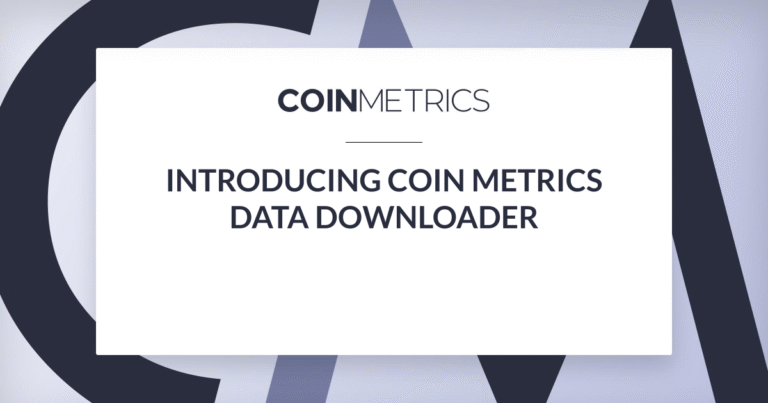Decentralized finance (DeFi) took over the crypto world during the summer. But it cooled off after September, and has taken a back seat to BTC and ETH since.
In this week’s Feature, we explore the rapid rise of DeFi tokens and the current state of DeFi’s market cap and usage. You can check out our DeFi data and recreate many of the charts featured in this piece using our free community charting tool.
DeFi’s Third Act
Although it may seem like it popped up overnight, DeFi has been around for years. During 2018 early projects like MakerDAO (MKR) and 0x (ZRX) pushed the total DeFi market cap to over $5B, as Ether (ETH) price reached all-time highs. But the initial DeFi surge was dwarfed by this summer’s run, which saw the rapid entry of many new projects.
Source: Coin Metrics Network Data Charts
DeFi’s recent rise began in earnest in June with the launch of Compound protocol’s COMP governance token. COMP’s launch kickstarted the rise of decentralized lending and borrowing, which served as the initial fuel for DeFi’s surge. Compound lets users borrow cryptoassets like ETH, DAI, and USDC using crypto as collateral. It also lets users lend their cryptoassets and earn yield, which has become a cornerstone of DeFi investing. In addition to Compound, Aave protocol has grown to be one of the largest DeFi decentralized lending platforms. Aave originally launched the LEND token, which they recently transitioned to the AAVE token.
Following COMP many other DeFi applications launched governance tokens during the summer of 2020. Yearn.finance, an application that automatically invests user’s funds into the highest yielding decentralized lending markets, launched the YFI governance token in mid-July. YFI was launched through incentivized liquidity pools which has become a popular way of launching DeFi tokens. YFI reached a market cap of over $1B by the end of August.
DeFi market cap peaked on September 18th shortly after the launch of Uniswap’s UNI governance token. Uniswap, the largest Ethereum-based decentralized exchange, has been the engine behind DeFi mania. Uniswap allows anyone to create a new token pair and immediately begin trading using decentralized liquidity pools, which helped new DeFi tokens launch and scale quickly. Uniswap trading volume increased from about $1M a day in early June to close to $1B a day in the beginning of September.
UNI was launched as an airdrop that rewarded previous Uniswap users and liquidity providers. Because of its sudden launch, UNI almost immediately catapulted DeFi market cap to a new all-time high. But soon after, the bubble began to burst. New UNI recipients started to sell their tokens en masse, causing UNI’s price to drop from a high of close to $7 to a low of less than $2. Additionally, a series of exploits and hacks led to large losses, which took more air out of the sector.
Source: Coin Metrics Network Data Charts
But DeFi market cap has started to turn back around. After reaching a local low on November 4th, DeFi market cap has returned back to late September levels following a surge from BTC and ETH. If BTC and ETH continue to rise, DeFi could be a big benefactor.
Usage Rebound
Similar to market cap, DeFi usage as measured by daily active addresses also peaked in September. Following the initial airdrop there were over 176K UNI active addresses on September 17th, by far the largest amount in DeFi history. But since then UNI daily active addresses have rapidly declined and leveled off at about 5K per day.
Source: Coin Metrics Network Data Charts
Removing UNI from the above chart shows that other DeFi tokens are regaining usage. Excluding UNI, the overall number of active addresses still peaked in early September, mostly due to the rise and fall of SushiSwap (SUSHI).
Source: Coin Metrics Network Data Charts
COMP usage has been growing since mid-October. COMP active addresses hit a new all-time high of 8,264 on November 11th.
Source: Coin Metrics Network Data Charts
MakerDAO and MKR activity has also been growing since October. MKR active addresses hit an all-time high of 2,281 on October 4th, and topped 2K again on November 10th. MakerDAO recently reached a new record of over $2.3B total value locked (TVL), passing the $2B mark in early November. And DAI, the decentralized stablecoin issued by MakerDAO, also hit a milestone in the last week, reaching a supply of 1B for the first time.
Source: Coin Metrics Network Data Charts
After dipping for most of October, YFI active addresses have shown some signs of life. There were 2,996 YFI active addresses on November 7th, the fourth highest daily total since its launch. YFI active addresses also topped 2K on November 10th.
Source: Coin Metrics Network Data Charts
Conclusion
After bottoming out in October, DeFi appears to be in the beginnings of a resurgence. Usage trends show that COMP and MKR activity has been growing. Overall, DeFi continues to grow and mutate, as experimentation continues. With new money flowing into BTC and ETH, new DeFi tokens and applications are likely soon to follow. If recent trends continue, another DeFi wave may soon be on the horizon.
To keep up with the latest DeFi trends and explore the assets in this article, check out our new DeFi data using our free community charting tool.



